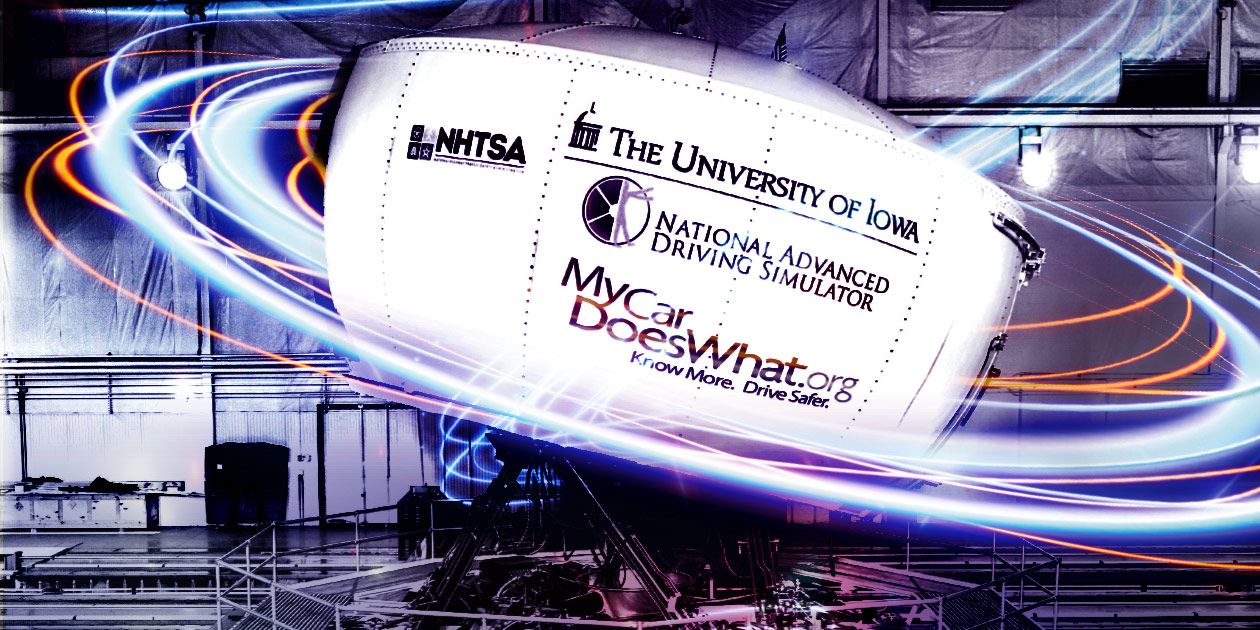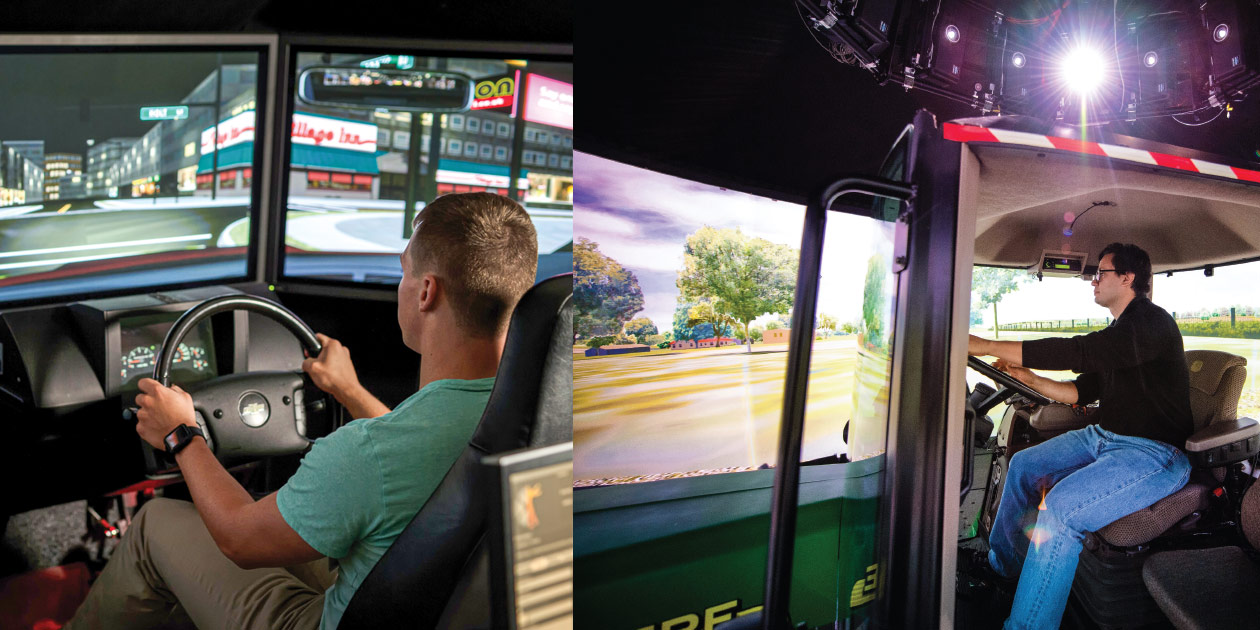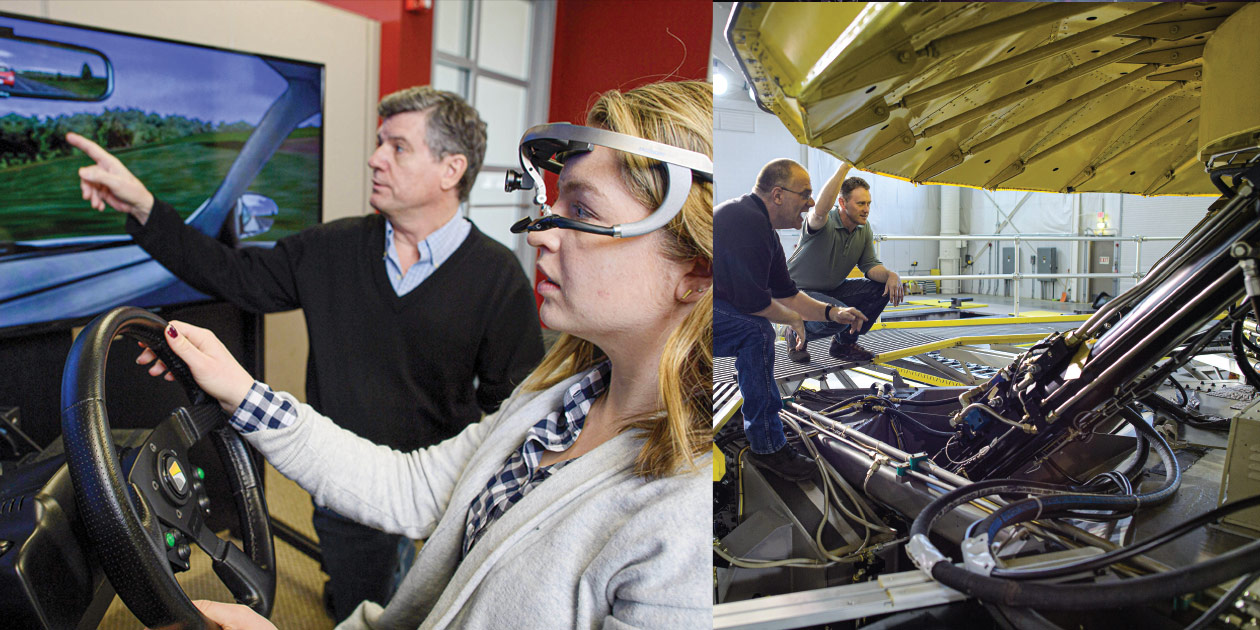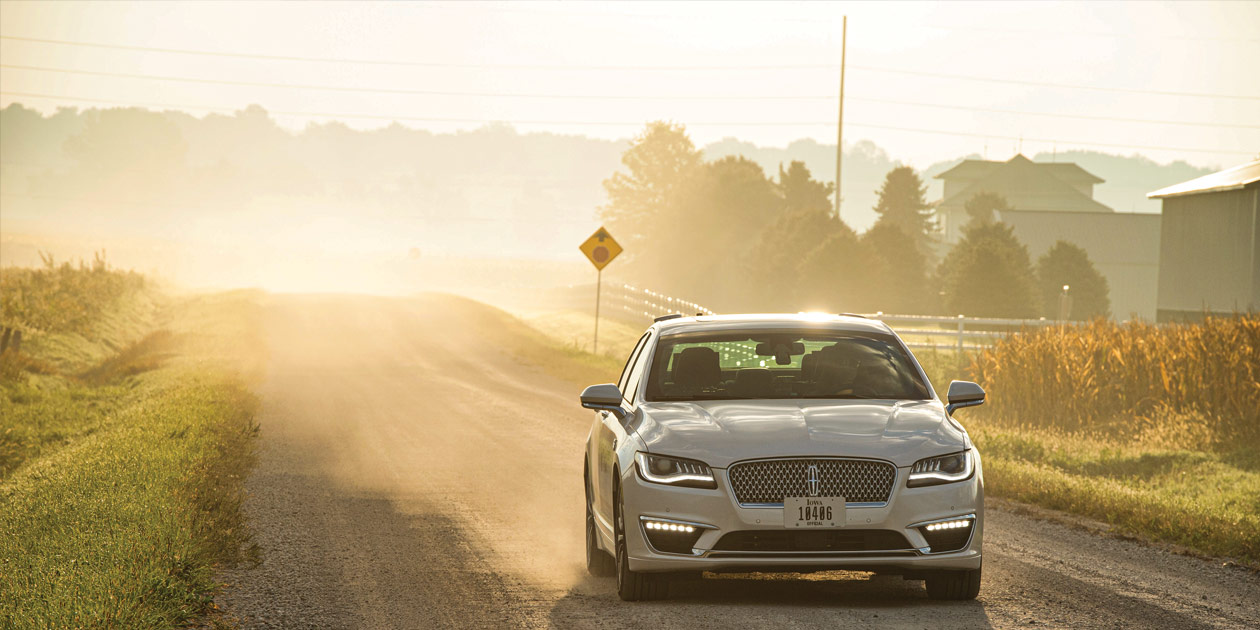The Road to the Future Runs Through Iowa
 PHOTOS BY JUSTIN TORNER
The NADS-1 simulator contains a full vehicle cab and a wraparound, high-definition screen that immerses test subjects in a virtual world.
PHOTOS BY JUSTIN TORNER
The NADS-1 simulator contains a full vehicle cab and a wraparound, high-definition screen that immerses test subjects in a virtual world.
The past and present of transportation intersect not far from Iowa City. Near the small town of Kalona, just a 30-minute drive south of the University of Iowa, horse-drawn buggies clop through the Amish countryside on their way to the bakery or general store. Meanwhile, modern-day sedans and SUVs zip past. They're guided by pinpoint GPS mapping, lane-keeping cameras, and collision-detection systems that light up the dash when they approach a slow-moving buggy or tractor.
Soon a vehicle from the future will also share the road here. UI engineers plan to roll out a new automated vehicle packed with research instruments for a multi-year study beginning in 2021. It's not quite a DeLorean, but the customized, automated Ford shuttle bus will travel in a 47-mile loop, carrying research subjects through Iowa City, Kalona, Riverside, and Hills. Fueled by a $7 million research grant from the U.S. Department of Transportation, the vehicle will gather data on the challenges rural roads present to automated driving systems and study how emerging technology can help older residents in rural communities overcome mobility barriers.
 Dan McGehee (left) is
director of the
National Advanced
Driving Simulator
Laboratories, based
in the UI College of
Engineering, and
associate professor
of industrial and
systems engineering,
emergency
medicine, public
health, and public
policy. Omar Ahmad (right),
NADS's deputy
director, is leading
the $7 million
Automated Driving
Systems for Rural
America study.
Dan McGehee (left) is
director of the
National Advanced
Driving Simulator
Laboratories, based
in the UI College of
Engineering, and
associate professor
of industrial and
systems engineering,
emergency
medicine, public
health, and public
policy. Omar Ahmad (right),
NADS's deputy
director, is leading
the $7 million
Automated Driving
Systems for Rural
America study.
The project is the latest mile marker in a long history of roadway safety research by the UI-based National Advanced Driving Simulator. NADS has been an international pacesetter in studying how humans interact with their vehicles since 1992, when the National Science Foundation and the National Highway Traffic Safety Administration selected Iowa to host the center over five other universities. Many of the crash avoidance features that are now standard in automobiles were first tested at Iowa, and today, NADS serves as one of the world's top hubs for advanced automotive driving research.
"There are a great number of technologies that have come through NADS over the years on their research, development, and regulatory journeys before production," says Dan McGehee, director of NADS laboratories. In the 1990s, the UI pioneered research on safety systems like anti-lock brakes, forward-collision warning, and lane-departure warnings. Later, a landmark UI study proved the effectiveness of electronic stability control—a system that corrects loss-of-control events like fishtailing by automatically shifting the braking to individual wheels—which led to the feature being required in the U.S. on all vehicles beginning in 2012.
Today's vehicles continue to blur the line between human and machine. Just a few years ago, tech companies and auto manufacturers boldly forecasted that fully automated vehicles would be on the road by 2020. In some ways, that's come to pass. Tesla's Autopilot feature allows the vehicle to take the wheel on the highway for short periods or be summoned from the garage. Google's subsidiary, Waymo, is testing self-driving vehicles this year in Arizona. And General Motors has rolled out its driverless Cruise prototypes on the streets of San Francisco.
Iowa's latest study—called Automated Driving Systems for Rural America—aims to steer automated technology beyond the city. While Silicon Valley is leading the pack on vehicle automation, Iowa's unique testing environment could help answer crucial questions. It's one thing to build a self-driving car that can maneuver through the sun-splashed streets of Palo Alto or wide-open highways of Arizona. It's another to navigate Iowa's unmarked country roads in a January snowstorm. In fact, while only 19% of Americans live in rural areas, rural roads account for 68% of the nation's total lane miles and 45% of roadway fatalities.
"When companies say they have a vehicle that will drive itself on roadways, one has to ask, which roadways are those?" says Omar Ahmad (93BS, 95MS, 14MBA), NADS's deputy director and project manager of the ADS for Rural America project. "They're likely going to be very predictable roadways. But it's important that the solutions are holistic solutions. We don't want these vehicles that work really well on certain types of roadways, but then their abilities fall apart when they're on a roadway that's not perfect."
So how far away are everyday Americans from having robo-cars that safely carry them from Point A to Point B, no matter where they live? Iowa's experts say it may be a longer, more winding road than meets the eye.
Teslas, Tractors, and Virtual Roads
Visiting the National Advanced Driving Simulator at the UI's Oakdale Campus is a bit like stepping into Q's spy gadget lab in a James Bond film. In the garage, research vehicles await on-road assignments. The fleet includes a Tesla Model S, a Volvo XC90 (license plate "AU2M8"), a Lincoln MKZ, and even an older Toyota Camry—a testing proxy for the average car. Each vehicle is laden with automated tech and retrofitted with specialized instruments that measure not only its performance, but the psychological and physiological responses of the research subjects behind the wheel.
Nearby, a door opens to reveal the cavernous bay that houses NADS-1, the crown jewel of the center and one of the most sophisticated driving simulators in the world. There, a space capsule-like dome holds a full vehicle cab and a wraparound, high-definition screen that immerses test subjects in a virtual world. The vehicle cab can be swapped out for a sedan, semi, or even a John Deere tractor, depending on the study. The capsule is mounted on a motion base that responds to the driver's cues behind the wheel, carrying the vehicle through the hangar in any direction. Overlooking the NADS-1 hangar, researchers in a control room observe testing and collect data, while down the hall and behind another closed door, a pre-production vehicle undergoes a "task analysis" for a major car manufacturer to determine how smoothly drivers are able to use its various functions with minimal distraction.
NADS also builds custom simulators for research institutions and companies around the world. Known as miniSims, the portable systems feature virtual driving scenarios developed by Iowa engineers that can be used to study safety, cognition, distraction, and impairment. "We've built everything from simple desktop systems with small displays to half a car with wraparound projection screens," says NADS engineer Andrew Veit (94BSE, 96MS), who manages the miniSim program. "Users can conduct repeated, safe, and less expensive experiments that you'd never be able to do on the road."
Between its on-road vehicles and the array of simulators, more than 40 faculty, staff, and students conduct research on roadway safety at NADS. A center within the UI College of Engineering, NADS is funded by a mix of government grants and contracts from partners in the auto industry. Current studies include inquiries into distracted, drowsy, and drugged driving; research on at-risk populations like novice and older drivers; and crash data analysis. "What we really do well is bring the human element into driving," explains Ahmad. "We understand human behavior and how to do studies that look at that."
 Inside the National
Advanced Driving
Simulator, a
miniSim system
is used for virtual
studies (left) and a
John Deere tractor
cab navigates a
virtual environment
in the NADS-1
simulator (right).
Inside the National
Advanced Driving
Simulator, a
miniSim system
is used for virtual
studies (left) and a
John Deere tractor
cab navigates a
virtual environment
in the NADS-1
simulator (right).
In NADS's ambitious ADS for Rural America study, engineers will use a custom shuttle bus equipped with scanning lasers known as LIDAR, computer vision systems, radar, and high-definition maps. A specially trained driver will be behind the wheel at all times to monitor the automated systems and take control when they're not in use. Additional researchers will be on board: one to serve as a co-pilot and another to assist study subjects as the van makes its circuit through Johnson and Washington counties. The instruments will collect data on how the automated systems perform on different types of roadways, including unmarked and unpaved roads, as well as the effects of varying weather conditions, times of day, and navigating unique traffic situations like ag equipment, construction zones, and football game days in Iowa City.
Researchers will also study the passengers, who will be rural residents ages 65 and older or people with a disability that affects their ability to drive. Over the course of two years and 80 drives, study leaders will capture the riders' physiological data, including stress and anxiety, and participants will answer a questionnaire gauging how much they trust the automated vehicle. Hundreds of terabytes of data will be made available for public analysis, benefiting other research institutions, government, and industry. Ahmad says the data will help illustrate the massive rural infrastructure upgrades needed to accommodate future automated vehicles, including better lane markings, lighting, or signals that can talk to vehicles. "Rural roadways are kind of a mixed bag right now," says Ahmad. "Improvements will have to be made if we want this technology to serve everyone."
Equally important, NADS researchers hope to highlight the promise automated vehicles hold for people with disabilities. Ahmad says the day could come when people who are uncomfortable driving or unable to drive can summon vehicles to their homes for rides to the grocery store or doctor's office. "It could make something that causes a lot of anxiety and planning go really smoothly," he says. "In fact, it could even encourage people to move out more into rural areas instead of having to live in urban areas where the services are."
Training the Next Generation of Visionaries
 Engineers conduct a miniSim demonstration (left) and examine the NADS-1 simulator's motion base (right).
Engineers conduct a miniSim demonstration (left) and examine the NADS-1 simulator's motion base (right).
Riding shotgun with NADS's experts are Iowa students who could become tomorrow's industry leaders. From undergrads to post-docs in backgrounds as varied as urban planning, geography, and psychology, young researchers get hands-on opportunities. Emily Shull (18BA) is a UI psychology graduate who is now working as a NADS research assistant while pursuing a PhD in industrial and systems engineering. Shull studies driver attention and performance when using partially automated vehicles, both on the road and in a simulator. She's in the process of publishing results from a recent study that evaluated the impact of informing the user of the automation's status in certain situations.
The mentorship Shull has received at NADS, coupled with the latitude she's given to develop her own research projects using her psychology background, has her poised for a career in transportation and automation. "I would love to continue doing research for vehicle manufacturers but, more importantly, for larger safety organizations that can then work to implement guidelines for design and production," she says.
NADS alumni can be found in laboratories around the world. From GM to Toyota, and Google to Apple, Iowa-trained researchers are playing a pivotal role in the development of tomorrow's automated vehicles. Among the auto industry's rising stars is recent UI graduate Omeed Kashef (19MS), an engineer at Ford Motor Company in Detroit. Kashef came to Iowa for graduate school at the UI College of Engineering because of its collaborative, interdisciplinary philosophy, which fit well with his varied academic interests. Kashef was able to hone his business development acumen through participation in the Student Accelerator Program in the UI's John Pappajohn Entrepreneurial Center while applying his human factors coursework to research projects at NADS.
"What we really do well is bring the human element into driving. We understand human behavior and how to do studies that look at that." —Omar Ahmad
"I gained a wealth of knowledge reading and digesting human-automation interaction research across decades, collaborating with academics and industry leaders from around the world, and working with a variety of driving simulators to develop research studies," Kashef says.
Today, Kashef is a customer experience developer at Ford, where he's part of a small team of engineers who design highly automated vehicles. "Our job is to work with a variety of interdisciplinary teams throughout the product development life cycle, from inception to production," he says.
Kashef envisions a future in which automated vehicles free up time for passengers to read, listen to music, work, or socialize. Automated vehicles might even help drivers arrive at their destinations sooner if speed limits increase, and they may be cleaner and cheaper, Kashef says. "However, we are nowhere near self-driving or fully autonomous vehicles on all roads and conditions for all people," he says. "That is simply because artificial general intelligence that's similar to humans has not been achieved."
Navigating the Roadblocks to Automation
 The interior of
the NADS-1 simulator outfitted
with a sedan (left) and the NADS
Tesla and new automated Ford
passenger van (right).
The interior of
the NADS-1 simulator outfitted
with a sedan (left) and the NADS
Tesla and new automated Ford
passenger van (right).
One day recently, McGehee was driving between Iowa City and the nearby town of Solon when a man darted across the highway. McGehee and other drivers pumped their brakes, and a truck narrowly avoided barreling over the pedestrian. It was a heart-stopping moment behind the wheel—and a reminder for McGehee of a major roadblock for automated vehicle engineers: predicting the unpredictable. While an attentive human driver can recognize and often navigate an unforeseen hazard, the ability to recognize and react to such roadway anomalies must be encoded with hard-and-fast rules in automated systems.
In 2018, an automated car built by Uber being tested with a safety driver struck and killed a jaywalking woman in Tempe, Arizona. The 49-yearold woman, who was pushing her bicycle while on foot, was attempting to cross the street at night outside a crosswalk. It was believed to be the first death involving an automated vehicle. Investigators later found the safety driver was watching a video on her phone while the vehicle, traveling at 39 mph, failed to identify the woman and bicycle as an imminent collision danger.
"The vast majority of our traffic interactions are pretty predictable," says McGehee. "You see a pedestrian standing at the edge of the street and recognize they might step out in front of us. We sense a bicycle up ahead. Those are fairly predictable. But if you study the crashes like the Uber fatality in Tempe, she had these plastic grocery sacks draped over the bicycle, so the automated system didn't recognize those two things together as a hazard. Those scenarios happen, and we need to be able to recognize all of those edge cases—events that are rare."
That brings McGehee back to the questions he's posed each time he talks about automated vehicles: When, exactly, will our cars be able to make those high-level decisions? How soon will our cars be driving us to the office while we recline with a coffee and newspaper? Unfortunately, says McGehee, it won't be as soon as the headlines sometimes suggest.
"Oftentimes the media inflates how quickly automated vehicles will be here," McGehee says. "There's a big difference between demonstrations like ours and ubiquitous automated driving."
 NADS's Lincoln MKZ research vehicle
NADS's Lincoln MKZ research vehicle
McGehee compares it to another technological leap, the smartphone, which took decades to evolve from landlines to our first primitive cell phones to the high-powered computers now found in the pockets of most Americans. While there will be incremental progress and major milestones ahead, McGehee says fully automated vehicles are decades away from achieving that same level of mass adoption in the U.S.
"It's likely to be 50 years or beyond," McGehee says. "This is going to take a lot longer than people think. It's not like it's just developing a new sensor system and putting it into production. There are much more complicated issues, as we've seen."
For researchers at NADS, the next leg of that journey begins on Iowa's country roads. Says Ahmad: "We don't want it to serve just a population in large, urban centers. We want the technology to work for everybody."
